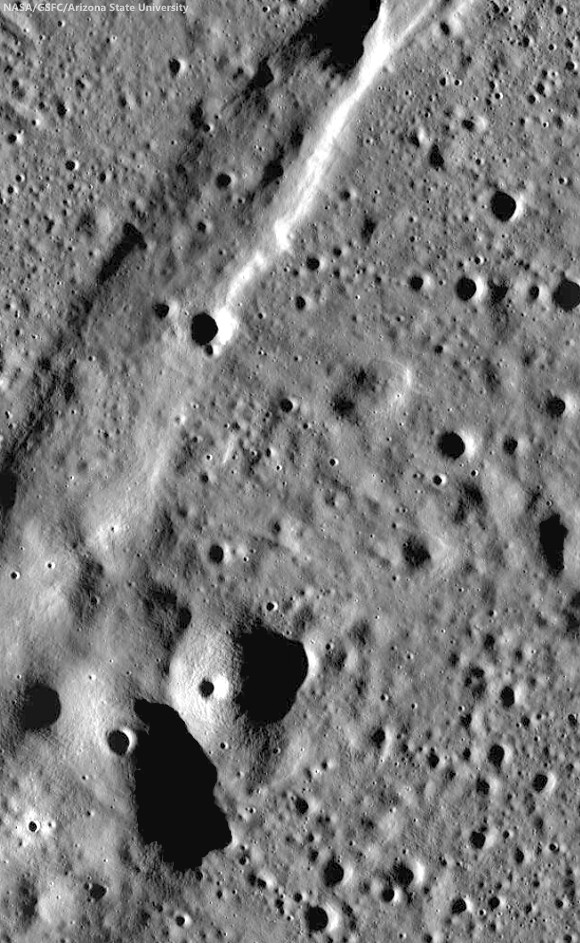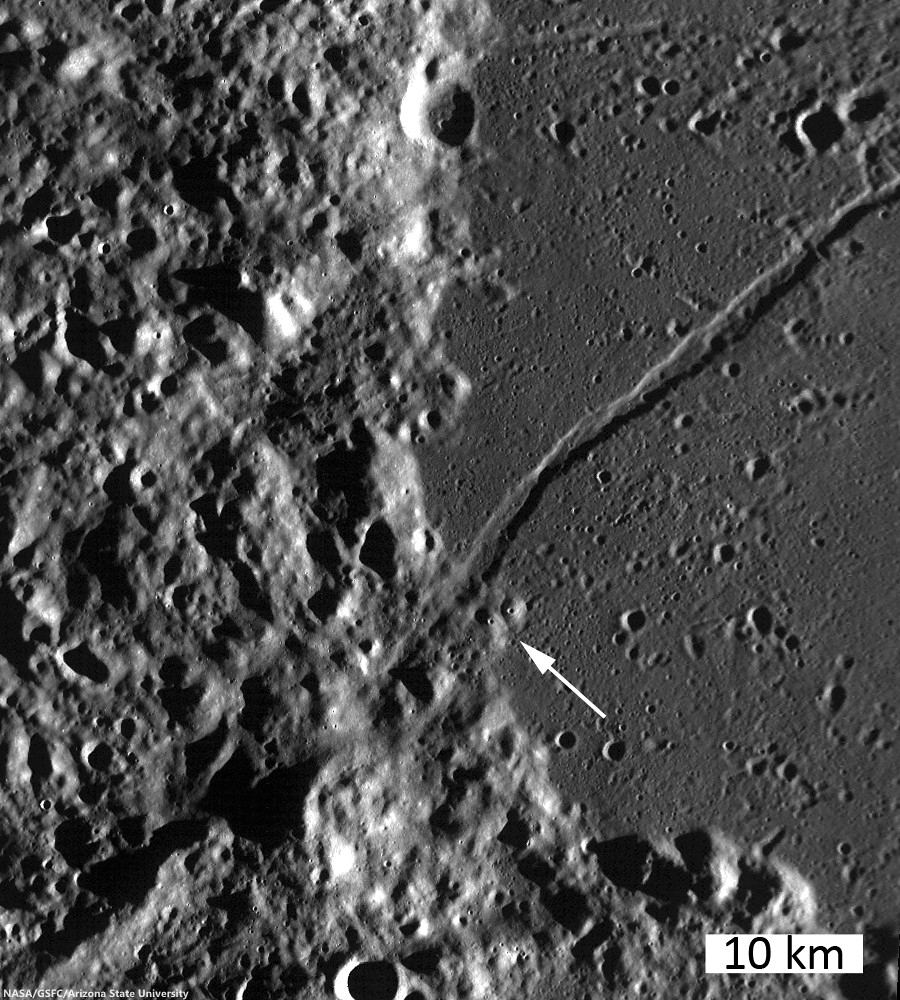 |
| Most of the craters on the Moon formed through impact processes. However, some craters, like the one visible in this portion of the LROC Featured Image "Volcanoes in the Lake of Death," August 11, 2010, may be a volcano summit pit crater. A 923 meter-wide field f view from LROC NAC observation M131488521R, LRO orbit 4511, June 18, 2010; resolution 93 cm per pixel, incidence angle 82.28° from 44.79 km over 44.11°N, 23.94°E [NASA/GSFC/Arizona State University]. |
When most people think about volcanism on the Moon, they usually consider the vast mare basalts located primarily on the lunar near side.
However, there are many different volcanic features on the Moon! Sinuous rilles, mare domes, non-mare domes, and pyroclastic deposits are several volcanic features that the LROC NAC studies at 0.50 m/pixel. The opening image in today's Featured Image is an exciting view of what may be the pit crater at the summit of a small volcano. These features which may be similar to terrestrial cinder or scoria cones.
In contrast to lunar volcanoes, such as mare domes, this pair of volcanoes is much smaller - they are only ~1.5 km across the widest portion of their bases (very small by lunar standards!).
Investigators during the Apollo years suggested that volcanic features like domes could be present in this region; with the tremendous capability of the LROC instruments, we can now take a closer look and begin to ascertain if this is indeed the case. Located at the highlands-mare boundary, these two features appear to be volcanic in origin and also isolated from other volcanic features (besides the mare) - other regions with prominent volcanoes exhibit several domes within close proximity to one another. So, why are there only two features here, which we interpret to be volcanic in origin? We can't really answer that question with just a single LROC NAC image pair and an LROC WAC monochrome context image of the immediate area. Instead, we need an LROC WAC mosaic that provides a regional view of Lacus Mortis so that any other volcanic or dome-like features can be observed.
linear rille (or graben) cutting through the mare, transitioning into a ridge in the highlands. Maybe this tectonic feature has something to do with the volcanic feature?
However, there are many different volcanic features on the Moon! Sinuous rilles, mare domes, non-mare domes, and pyroclastic deposits are several volcanic features that the LROC NAC studies at 0.50 m/pixel. The opening image in today's Featured Image is an exciting view of what may be the pit crater at the summit of a small volcano. These features which may be similar to terrestrial cinder or scoria cones.
In contrast to lunar volcanoes, such as mare domes, this pair of volcanoes is much smaller - they are only ~1.5 km across the widest portion of their bases (very small by lunar standards!).
 |
| From "Lunar Morphology in the Lake of Death," Dec. 17, 2009: Close up on southwestern Lacus Mortis and a 700 meter wide section of 104 km-long graben Rimae Bürg near where it translates from the mare-filled "lake" into the highlands beyond its shore. LRO orbit 211, July 12, 2009; alt. 162.49 km, native res = 1.6 m [NASA/GSFC/Arizona State University]. |
linear rille (or graben) cutting through the mare, transitioning into a ridge in the highlands. Maybe this tectonic feature has something to do with the volcanic feature?
The Lunar Reconnaissance Orbiter is gradually adding granularity to long-familiar lunar features, like Lacus Mortis. Above, a sampling of LROC NAC observations in southwest Lacus Mortis show how differing illumination angles and altitudes compliment each other to build up what may soon be a first, truly complete view of the lunar surface.
From the LROC WAC frame we cannot distinguish relative ages between the volcanic features and rille, so determining the relationship between these features (if any) remains a mystery (at this time). Clearly, the geology of this immediate area is complex and is a worthwhile candidate for future lunar exploration!
Explore the landscape of Lacus Mortis for yourself, HERE.
Explore the landscape of Lacus Mortis for yourself, HERE.
Blogger's Best for the Best, December 6, 2009
Terraced Wall of Bürg, July 31, 2009



2 comments:
Hi, I saw your post about volcanoes. Just before that, I found what i think is a volcano on Mars. Could you check it and tell me if it is? You can find it here:
http://marsweirdness.blogspot.com
Thanks!
Yes, that definitely looks like a volcano. On first glance, without making the effort to grasp the image scale, that feature looks a great deal like one of the great shield volcanoes of Tharsis, headed up by Mons Olympus. (Is that ginormous volcano on Mars still considered the largest in the solar system?)
You comment made me take another look at Lacus Mortis on the Moon, as a matter of fact. Without looking at the elevation models, that whole feature's strange appearance also looks like a shield volcano.
Interesting site, DK. We'll look over it in more detail.
Post a Comment